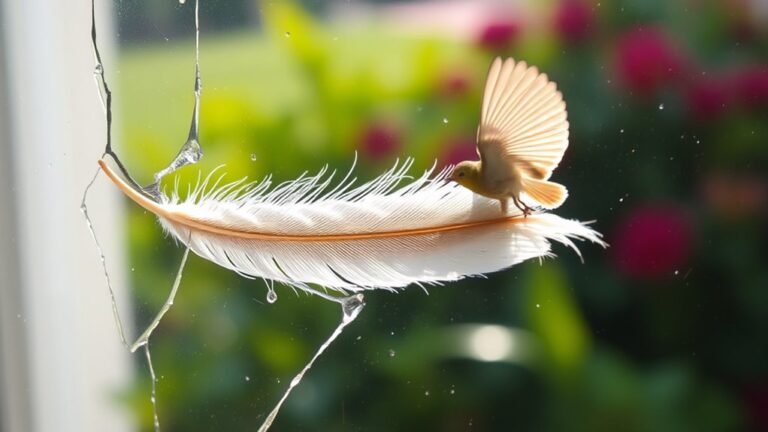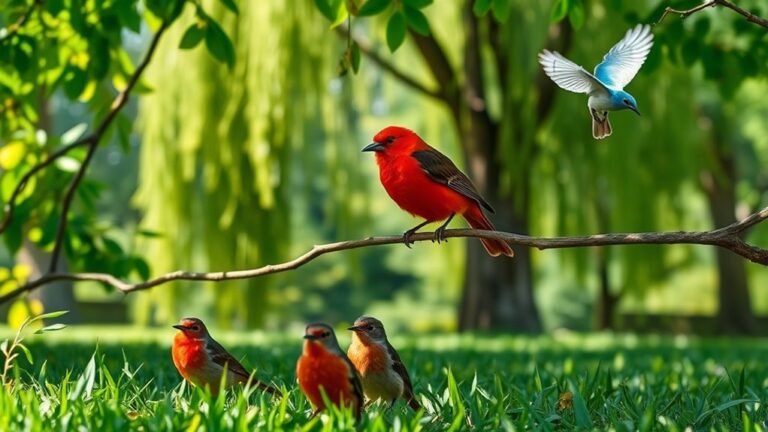Understanding the Symbolism of Dead Birds
Encountering a dead bird evokes strong emotions. These delicate beings often represent more than loss; they encourage thoughts on change and the fragile nature of life. Many cultures share stories about dead birds, examining ideas of death and rebirth. They also prompt us to reflect on our relationships with nature and the experience of grief. Their presence invites us to explore these themes further.
Key Takeaways
- Dead birds symbolize loss, change, and the fragility of life, reflecting the emotional weight of mortality and change.
- In literature and poetry, dead birds depict disillusionment and unfulfilled dreams, confronting deeper human experiences and vulnerabilities.
- Cultural folklore associates dead birds with spiritual signs and myths, emphasizing life, death, and personal transformation through rituals.
- Environmentally, dead birds highlight humanity's impact on ecosystems, serving as reminders of our responsibility toward nature and its fragility.
- Overall, dead birds embody the duality of death as both an ending and a necessary transformation, inviting reflection on life's cycles.
Cultural Interpretations of Dead Birds

Dead birds hold significant meaning in many cultures, representing loss, change, and the fragility of life. They often feature in cultural stories and rituals related to death.
Many beliefs view dead birds as messengers with deep connections to the afterlife. Some cultures see them as signs of bad luck or impending change.
The Connection Between Death and Transformation
Death often represents a significant transformation in many cultures. It isn't just an ending; it can lead to new beginnings.
Rituals surrounding death help you process loss and allow for reflection and growth.
When a bird dies, it illustrates this cycle. Endings can signal the start of something new.
Mourning provides space to understand grief better and discover deeper meanings.
Death connects you to a broader life narrative that embraces rebirth and renewal.
This perspective invites you to feel linked to something greater, allowing change and progress in your life.
Dead Birds in Literature and Poetry

Birds typically symbolize freedom and the soul's journey. However, when birds appear lifeless in literature and poetry, their meaning shifts.
Dead birds often represent loss, disillusionment, and the fragility of life. They can symbolize broken dreams or harsh realities. In Edgar Allan Poe's "The Raven," dead birds serve as a strong symbol of mourning and despair.
As you read, pay attention to how these images reshape ideas about hope. They encourage you to face your fears and vulnerabilities. By examining the symbolism of dead birds, you engage with deeper truths about human experiences and uncertainties in life.
Symbolism in Art and Visual Expressions
While examining symbolism in art and visual expressions, you'll find that dead birds communicate strong emotional messages. Their depiction evokes feelings of loss, sadness, and reflection, allowing insight into human experiences.
These images often connect with shared emotions and cultural stories.
- They show mortality and fragility.
- They represent lost dreams.
- They illustrate freedom turned into confinement.
- They symbolize nature taking back its space.
- They explore silence in the midst of chaos.
Engaging with these symbols encourages you to reflect on meaningful themes, fostering connection and understanding in a world filled with uncertainty.
Folklore and Mythological Significance

Dead birds appear in many cultures and hold significant meaning in folklore and mythology. These symbols often connect to ancient beliefs about life and death. They sometimes serve as spiritual signs that prompt individuals to reflect on their life's journey.
Various mythical creatures feature in stories about dead birds, adding layers of meaning to the narratives. Folklore influences cultural rituals, enriching death practices with insight and purpose.
As you explore these stories, you'll notice that dead birds symbolize deep thoughts on mortality and the afterlife. They reflect how societies understand death.
Psychological Reflections of Death and Loss
The sight of dead birds can evoke strong feelings about death and loss. This image often connects with personal experiences and memories, highlighting the emotional impact of grief.
When you see a dead bird, it may represent:
- The end of a valued relationship
- A sense of vulnerability
- The reality of life's impermanence
- Memories that turn into nostalgia
- The need for closure and healing
These reflections encourage you to explore your emotions and experiences.
They show how thoughts of mortality influence your understanding of life, helping you find a sense of connection even during times of loss.
Environmental Messages and Ecological Concerns
A dead bird found in nature reminds us of humanity's impact on the environment. This sight highlights the reality of environmental harm and climate change.
Each lifeless bird, tangled in the underbrush, shows the fragility of ecosystems we often overlook. This moment can inspire action, encouraging us to recognize our connection to all living beings.
As we understand that our choices affect these creatures, our relationship with nature becomes stronger. By recognizing the meaning of dead birds, we can develop a sense of belonging and responsibility.
Together, we can work to protect our planet for future generations.
Spiritual Meanings and Afterlife Beliefs
Many people view a dead bird as a sign of loss. In various spiritual traditions, this event can symbolize deeper meanings related to life and death.
Here are some common interpretations:
- The soul's journey beyond life
- A link between the physical and spiritual worlds
- A sign of change and new beginnings
- A prompt for spiritual support during difficult times
- A reflection on your own life and mortality
By understanding these interpretations, you can connect with human experiences and recognize life's cycles.
This awareness can foster a sense of belonging to something larger than ourselves.
The Role of Dead Birds in Personal Grief and Healing
A dead bird can symbolize loss and also represent personal grief and healing. When you see a lifeless bird, it may remind you of your own feelings of grief. This symbol encourages you to address emotions that you may have suppressed.
As you work through your healing, the dead bird can highlight the fragility of life and the need to acknowledge what's been lost. Embracing this meaning helps you feel a connection to others who face similar challenges.
In this way, the dead bird becomes a powerful reminder for reflection and growth during your grief journey.
Frequently Asked Questions
What Are Common Species of Birds Associated With Death Symbolism?
Crows and ravens are common birds that symbolize death. They are often seen as messengers of the unknown. Their dark colors and behavior connect people to the idea of transformation. These birds represent life's mysteries and the cultural beliefs that shape how we view mortality.
How Do Dead Birds Appear in Different Religions?
In various religions, dead birds represent transformation and spiritual beliefs. Different cultures interpret these symbols in unique ways. Some view dead birds as messengers from the divine, while others see them as signs of change. These interpretations connect us to traditions around the world, offering insights into how different communities understand life and death.
Can Dreams About Dead Birds Have Specific Meanings?
Dreams about dead birds can symbolize feelings of loss or change. These dreams often reflect your emotional state, prompting you to process your feelings. Understanding these symbols can guide you in your journey toward healing. Consider your personal experiences and feelings when interpreting these dreams. Their meanings may vary based on your cultural background and life situations.
Are There Scientific Explanations for Bird Deaths?
Birds often die in large numbers, and several factors contribute to this phenomenon. Common causes of bird deaths include habitat loss and pollution. Environmental studies help us understand how these issues impact bird populations. By learning about these factors, we can appreciate nature's delicate balance even more. Recognizing the reasons behind bird mortality can motivate us to protect their habitats and promote healthier environments.
What Role Do Birds Play in Various Superstitions?
Birds hold significant meaning in various cultures. Many people see them as omens or messages from a higher power. Different societies interpret the presence of birds in unique ways, shaping beliefs over time. Understanding these interpretations helps us see how birds connect with human experiences and emotions.

Hello, I’m Emily Price, the founder of Birds Affection. As a passionate bird enthusiast and spiritual seeker, I’ve always been fascinated by the symbolic meanings and mystical connections between birds and our lives. On this website, I share my knowledge and insights on the spiritual significance of various bird species, exploring their roles as messengers, guides, and teachers. Through my writing, I aim to inspire and educate others on the profound wisdom and beauty that birds bring to our world. Join me on this journey as we delve into the enchanting realm of bird symbolism and discover the hidden meanings behind these magnificent creatures.







